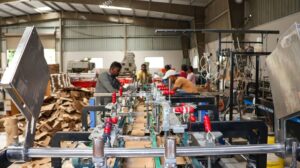The Future of Fulfillment: Micro-Warehouses and Hyperlocal Delivery
- Mar 07, 2025

In the fast-paced world of e-commerce and retail, customer expectations are evolving rapidly. Consumers no longer just want fast shipping—they demand it. The rise of giants like Amazon has set a new standard for delivery times, pushing businesses to rethink their fulfillment strategies. Enter micro-warehouses and hyperlocal delivery, two innovations that are reshaping the future of fulfillment. Together, they promise to bring products closer to consumers, reduce delivery times, and create a more sustainable supply chain. In this blog, we’ll explore how these concepts are transforming the logistics landscape and what they mean for businesses and consumers alike.
What Are Micro-Warehouses?
Micro-warehouses, also known as urban fulfillment centers, are small, strategically located storage facilities designed to hold high-demand inventory closer to densely populated areas. Unlike traditional warehouses, which are often located on the outskirts of cities, micro-warehouses are embedded within urban centers, enabling businesses to respond to customer demands with unprecedented speed.
These compact facilities leverage automation, robotics, and advanced inventory management systems to optimize space and efficiency. By storing products closer to the end consumer, businesses can significantly reduce the time and cost associated with last-mile delivery—the final and most expensive leg of the supply chain.
The Rise of Hyperlocal Delivery
Hyperlocal delivery refers to the process of delivering goods from a local store or micro-warehouse to a customer within a very short distance, often within the same neighborhood or city. This model relies on a network of local hubs and delivery personnel to ensure that products reach customers in record time—sometimes within hours or even minutes.
The concept of hyperlocal delivery is not entirely new. Grocery stores and restaurants have been offering local delivery for years. However, advancements in technology, such as real-time tracking, route optimization, and AI-powered demand forecasting, have made it possible to scale hyperlocal delivery across a wide range of industries, from fashion to electronics.
Why Micro-Warehouses and Hyperlocal Delivery Matter
- Faster Delivery Times
The primary advantage of micro-warehouses and hyperlocal delivery is speed. By positioning inventory closer to consumers, businesses can offer same-day or even one-hour delivery, meeting the growing demand for instant gratification. - Reduced Shipping Costs
Last-mile delivery is the most expensive part of the supply chain. By shortening the distance between the warehouse and the customer, businesses can cut down on transportation costs and pass those savings on to consumers. - Sustainability
Shorter delivery routes mean fewer emissions, contributing to a greener supply chain. Additionally, micro-warehouses can be designed with energy-efficient technologies, further reducing their environmental impact. - Improved Inventory Management
Micro-warehouses allow businesses to store smaller quantities of high-demand products in multiple locations, reducing the risk of overstocking or stockouts. Advanced analytics can help predict demand and optimize inventory levels in real time. - Enhanced Customer Experience
Faster delivery and lower costs lead to happier customers. In a competitive market, providing a seamless and speedy fulfillment experience can be a key differentiator.
Challenges and Considerations
While micro-warehouses and hyperlocal delivery offer numerous benefits, they also come with challenges:
- Real Estate Costs: Securing space in urban areas can be expensive, making it difficult for smaller businesses to adopt this model.
- Operational Complexity: Managing a network of micro-warehouses requires sophisticated technology and logistics expertise.
- Scalability: Expanding this model to less densely populated areas may not be feasible due to lower demand and higher costs.
- Labor Intensity: Hyperlocal delivery relies heavily on human labor, which can be a bottleneck during peak demand periods.
The Role of Technology
Technology is the backbone of this new fulfillment model. Key innovations driving the success of micro-warehouses and hyperlocal delivery include:
- Automation and Robotics: Automated storage and retrieval systems (ASRS) and robots can maximize space and efficiency in micro-warehouses.
- Artificial Intelligence: AI-powered demand forecasting and route optimization tools ensure that the right products are in the right place at the right time.
- IoT and Real-Time Tracking: Internet of Things (IoT) devices enable real-time monitoring of inventory and delivery vehicles, improving transparency and efficiency.
- Blockchain: Blockchain technology can enhance supply chain visibility and security, ensuring that products are sourced and delivered ethically.
Global Implications and the Role of Global Pluugin
The shift toward micro-warehouses and hyperlocal delivery is not just a trend—it’s a global movement. As businesses around the world adopt these strategies, the need for seamless integration and collaboration across borders becomes increasingly important. This is where platforms like Global Pluugin come into play.
Global Plugin specializes in helping businesses navigate the complexities of modern fulfillment. With expertise in real-time data sharing, inventory synchronization, and cross-border logistics, Global Plugin empowers businesses to streamline their operations and deliver a consistent customer experience, no matter where they are in the world. Whether you’re a small business looking to expand or a multinational corporation optimizing your supply chain, Global Plugin provides tailored solutions to help you stay ahead in the era of micro-warehouses and hyperlocal delivery.
Ready to take your fulfillment strategy to the next level? Explore how Global Plugin can help you achieve global connectivity and efficiency. Learn more about Global Plugin here.
You May Also like This
Popular Posts
-
 The Rise of Autonomous Stores: Will eCommerce Replace Traditional Retail Entirely?
The Rise of Autonomous Stores: Will eCommerce Replace Traditional Retail Entirely? -
 SEO for eCommerce: How to Rank Higher and Drive More Organic Sales
SEO for eCommerce: How to Rank Higher and Drive More Organic Sales -
 AI as Your Co-Founder: How Generative AI Is Changing eCommerce Business Models
AI as Your Co-Founder: How Generative AI Is Changing eCommerce Business Models -
 How to Scale Your Fulfillment Operations During Peak Seasons
How to Scale Your Fulfillment Operations During Peak Seasons -
 The Future of Fulfillment: Micro-Warehouses and Hyperlocal Delivery
The Future of Fulfillment: Micro-Warehouses and Hyperlocal Delivery







